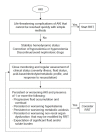When and why to start continuous renal replacement therapy in critically ill patients with acute kidney injury
- PMID: 34781642
- PMCID: PMC8685358
- DOI: 10.23876/j.krcp.21.043
When and why to start continuous renal replacement therapy in critically ill patients with acute kidney injury
Abstract
Acute kidney injury (AKI) is a common condition in critically ill patients, and may contribute to significant medical, social, and economic consequences, including death. Although there have been advances in medical technology, including continuous renal replacement therapy (CRRT), the mortality rate of AKI is high, and there is no fundamental treatment that can reverse disease progression. The decision to implement CRRT is often subjective and based primarily on the clinician's judgment without consistent and concrete guidelines or protocols regarding when to initiate and discontinue CRRT and how to manage complications. Recently, several randomized controlled trials addressing the initiation of renal replacement therapy in critically ill patients with AKI have been completed, but clinical application of the findings is limited by the heterogeneity of the objectives and research designs. In this review, the advantages and disadvantages of CRRT initiation, clinical guideline recommendations, and the results of currently published clinical trials and meta-analyses are summarized to guide patient care and identify future research priorities.
Keywords: Acute kidney injury; Continuous renal replacement therapy; Guideline; Meta-analysis; Randomized controlled trial.
Conflict of interest statement
All authors have no conflicts of interest to declare.
Figures


Similar articles
-
[Effect of early initiation of continuous renal replacement therapy based on the KDIGO classification on the prognosis of critically ill patients with acute kidney injury].Zhonghua Wei Zhong Bing Ji Jiu Yi Xue. 2016 Mar;28(3):246-51. Zhonghua Wei Zhong Bing Ji Jiu Yi Xue. 2016. PMID: 29917340 Chinese.
-
Predictive value of RIFLE classification on prognosis of critically ill patients with acute kidney injury treated with continuous renal replacement therapy.Chin Med J (Engl). 2009 May 5;122(9):1020-5. Chin Med J (Engl). 2009. PMID: 19493435
-
Accelerated versus standard initiation of renal replacement therapy for critically ill patients with acute kidney injury: a systematic review and meta-analysis of RCT studies.Crit Care. 2021 Jan 5;25(1):5. doi: 10.1186/s13054-020-03434-z. Crit Care. 2021. PMID: 33402204 Free PMC article.
-
Prognostic Impact of Early Versus Late Initiation of Renal Replacement Therapy Based on Early Warning Algorithm in Critical Care Patients With Acute Kidney Injury.Ther Apher Dial. 2020 Aug;24(4):445-452. doi: 10.1111/1744-9987.13449. Epub 2019 Nov 29. Ther Apher Dial. 2020. PMID: 31661596
-
Management for Electrolytes Disturbances during Continuous Renal Replacement Therapy.Electrolyte Blood Press. 2022 Dec;20(2):64-75. doi: 10.5049/EBP.2022.20.2.64. Epub 2022 Dec 30. Electrolyte Blood Press. 2022. PMID: 36688209 Free PMC article. Review.
Cited by
-
Volume control strategy and patient survival in sepsis-associated acute kidney injury receiving continuous renal replacement therapy: a randomized controlled trial with secondary analysis.Sci Rep. 2024 Jun 21;14(1):14284. doi: 10.1038/s41598-024-64224-z. Sci Rep. 2024. PMID: 38902283 Free PMC article. Clinical Trial.
-
Data-driven prediction of continuous renal replacement therapy survival.Nat Commun. 2024 Jun 27;15(1):5440. doi: 10.1038/s41467-024-49763-3. Nat Commun. 2024. PMID: 38937447 Free PMC article.
-
Early Urine Output in the Emergency Room as a Prognostic Indicator for Critically Ill Patients Undergoing Continuous Renal Replacement.Life (Basel). 2025 May 27;15(6):866. doi: 10.3390/life15060866. Life (Basel). 2025. PMID: 40566520 Free PMC article.
-
Factors Affecting Continuous Renal Replacement Therapy (CRRT) in Patients With Septic Shock: An Analysis of a National Inpatient Sample Database.Cureus. 2024 Nov 24;16(11):e74356. doi: 10.7759/cureus.74356. eCollection 2024 Nov. Cureus. 2024. PMID: 39720367 Free PMC article.
-
A Retrospective Study on the Start and End of Continuous Hemodialysis Using a Polymethylmethacrylate Hemofilter for Severe Acute Pancreatitis.Intern Med. 2024 Aug 15;63(16):2241-2249. doi: 10.2169/internalmedicine.2708-23. Epub 2024 Jan 13. Intern Med. 2024. PMID: 38220199 Free PMC article.
References
-
- Tolwani A. Continuous renal-replacement therapy for acute kidney injury. N Engl J Med. 2012;367:2505–2514. - PubMed
-
- An JN, Hwang JH, Kim DK, et al. Chronic kidney disease after acute kidney injury requiring continuous renal replacement therapy and its impact on long-term outcomes: a multicenter retrospective cohort study in Korea. Crit Care Med. 2017;45:47–57. - PubMed
LinkOut - more resources
Full Text Sources

